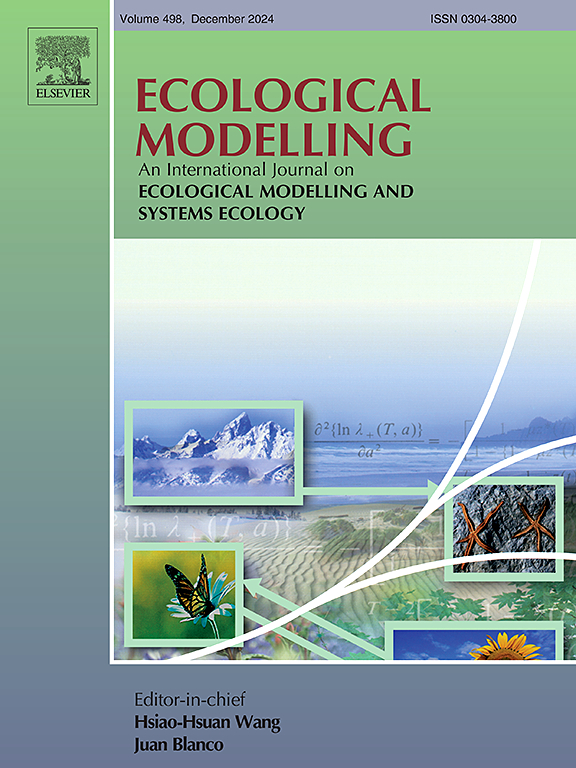Improving process-based modeling of crop production in the DayCent ecosystem model with solar-induced chlorophyll fluorescence
IF 2.6
3区 环境科学与生态学
Q2 ECOLOGY
引用次数: 0
Abstract
Solar-induced chlorophyll fluorescence (SIF), as the red and far‐red light emitted from excited chlorophyll‐a molecules during photosynthesis, has been increasingly used for estimating gross primary production (GPP). DayCent is a process-based ecosystem model that mechanistically simulates time-dependent biogeochemical processes of the plant and soil system at a daily time-step. The present study explored a series of key modifications to develop photosynthetic equations with the Mechanistic Light Response (MLR) framework. We used published ground‐based measurements derived from five cropland sites with multiple years of data in the central region of United States to calibrate and evaluate the MLR framework in DayCent. Three versions of the DayCent SIF model were developed and tested based on variation in algorithms and main parameters in MLR equation. The best fit model version for predicting seasonal GPP rates used temperature to capture the seasonal variation of the maximum photochemical efficiency of photosystem II (ΦPSIImax) and directly calculated the intercellular CO2 concentration (Ci) based on Eco-Evolutionary Optimality (EEO) theory, with index of agreement (IA) varying between 0.76 and 0.88 and root mean square error (RMSE) between 3.93 and 6.76 g C m−2 d-1. This version of the model also has significantly better agreement with measured GPP, as demonstrated by higher IA value and lower RMSE value when compared to conventional Radiation Use Efficiency (RUE) approaches, even when informed by the MODIS Enhanced Vegetation Index (EVI). This study demonstrates that a mechanistic modeling framework informed by SIF observations can improve process-based modeling of crop production.
利用太阳诱导叶绿素荧光改进DayCent生态系统模型中基于过程的作物生产模型
太阳诱导叶绿素荧光(SIF)是光合作用过程中激发的叶绿素-a 分子发出的红光和远红光,越来越多地被用于估算总初级生产力(GPP)。DayCent 是一个以过程为基础的生态系统模型,从机理上模拟了植物和土壤系统以日为时间单位的生物地球化学过程。本研究探索了一系列关键的修改,以利用光响应机制(MLR)框架开发光合作用方程。我们使用了从美国中部地区五个耕地站点获得的多年数据,对 DayCent 中的 MLR 框架进行了校准和评估。根据算法和 MLR 方程中主要参数的变化,我们开发并测试了三个版本的 DayCent SIF 模型。预测季节性 GPP 速率的最佳拟合模型版本使用温度来捕捉光系统 II 最大光化学效率(ΦPSIImax)的季节性变化,并根据生态进化优化(EEO)理论直接计算胞间 CO2 浓度(Ci),其一致指数(IA)在 0.76 和 0.88 之间变化,均方根误差(RMSE)在 3.93 和 6.76 g C m-2 d-1 之间变化。与传统的辐射利用效率(RUE)方法相比,这一版本的模型与测量的 GPP 的一致性也明显更好,表现为更高的 IA 值和更低的 RMSE 值,即使以 MODIS 增强植被指数(EVI)为参考也是如此。这项研究表明,以 SIF 观测数据为依据的机理建模框架可以改进基于过程的作物生产建模。
本文章由计算机程序翻译,如有差异,请以英文原文为准。
求助全文
约1分钟内获得全文
求助全文
来源期刊

Ecological Modelling
环境科学-生态学
CiteScore
5.60
自引率
6.50%
发文量
259
审稿时长
69 days
期刊介绍:
The journal is concerned with the use of mathematical models and systems analysis for the description of ecological processes and for the sustainable management of resources. Human activity and well-being are dependent on and integrated with the functioning of ecosystems and the services they provide. We aim to understand these basic ecosystem functions using mathematical and conceptual modelling, systems analysis, thermodynamics, computer simulations, and ecological theory. This leads to a preference for process-based models embedded in theory with explicit causative agents as opposed to strictly statistical or correlative descriptions. These modelling methods can be applied to a wide spectrum of issues ranging from basic ecology to human ecology to socio-ecological systems. The journal welcomes research articles, short communications, review articles, letters to the editor, book reviews, and other communications. The journal also supports the activities of the [International Society of Ecological Modelling (ISEM)](http://www.isemna.org/).
 求助内容:
求助内容: 应助结果提醒方式:
应助结果提醒方式:


